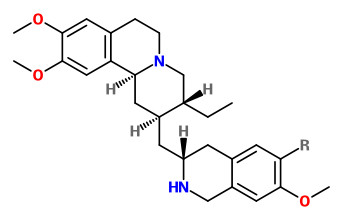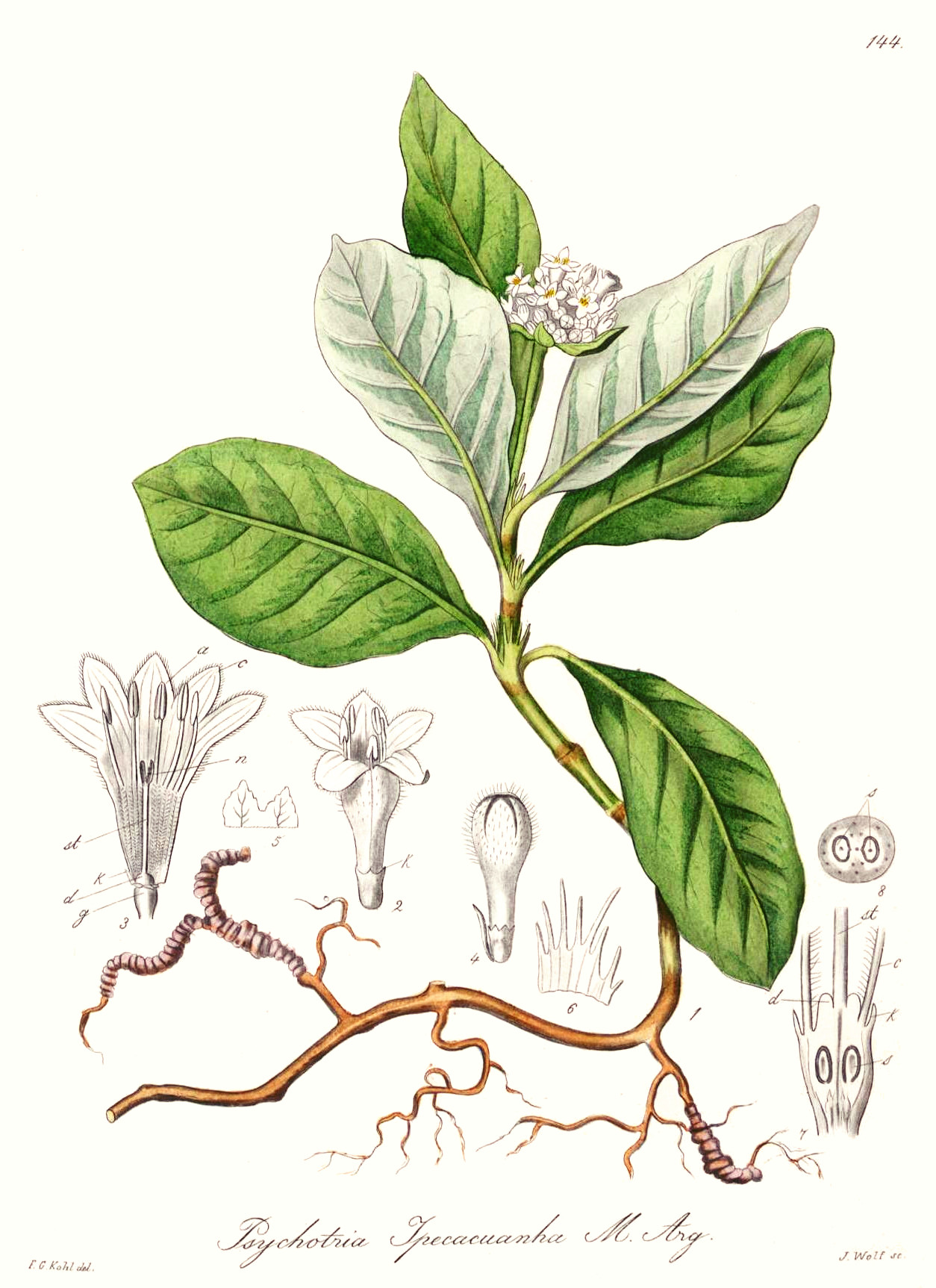Dies ist eine alte Version des Dokuments!
Carapichea ipecacuanha (Brot.) L.Andersson - syn. Cephaelis ipecacuanha (Brot.) A.Rich.; Psychotria ipecacuanha (Brot.) Stokes; Uragoga ipecacuanha (Brot.) Baillon; Callicocca ipecacuanha Brot. - Rubiaceae
ipecacuanha, ipecac, Brasilianische Ipecacuanha, Brasilianische Brechwurzel, Rio-Ipecacuanha
Evergreen shrub, up to 40cm high, native to South America, Central America, also cultivated; root knotty, with transverse rings; leaves opposite, simple, elliptic, acuminate; flowers small, white, funnel-shaped.
Cephaelis acuminata H.Karst. (syn. Uragoga granatensis Baillon) also known as Cartagena-Ipecacuanha, Panama-Ipecacuanha, or Nicaragua-Ipecacuanha, is know also neotypificated to Carapichea ipecacuanha. http://www.tropicos.org/Name/27911397?tab=acceptednames
When the ipecac alkaloids cephaeline, emetine and the synthetic 2-dehydroemetine (as dihydrochlorides) were administered to rabbits and cats, the effects of the three alkaloids on respiratory tract were identical. The volume output of respiratory tract fluid was increasingly augmented by doses of from 0.1 to 1.0 mg/kg. Doses of from 9.0 to 81 mg/kg were increasingly lethal.
[The expectorant action of cephaeline, emetine and 2‐dehydroemetine., Boyd, E.M., Knight, L.M., Journal of Pharmacy and Pharmacology, 16(2), 1964, 118-124]
 cephaeline (R=OH), emetine (R=OMe)
cephaeline (R=OH), emetine (R=OMe)
European Pharmacopoeia require alkaloid contents of the root drug by 2% (AB-DDR 1.9-2.1%, Ph.Helv.VII min.2.0%, ÖAB and DAB 1.8-4%).
[Wichtl, Max. Teedrogen, Teedrogen und Phytopharmaka, Stuttgart 2002, 252-253]
Ipecac roots are used because of their expectorant, amoebicidal and emetic properties. „The crude drug is not suitable for self-medication as the doese has to be very carefully measured… the alkaloids irritate the nervus vagus in the stomach; this stimulates water secretion in bronchial tissues in a reflectory way, resulting in the known expectorant and secretolytic activities (note that saponins apparently work in the same way!).“
At about 10 times the therapeutic dose of ipecac extract used to treat chronic bronchitis, it is strongly emetic. The extract is used in emetic syrups to induce vomiting in case of accidental poisoning. As emetine (methylcephaeline) intercalates DNA and blocks protein biosynthesis, it is cytotoxic and used as anti-amoebic drug.
[Medicinal Plants of the World. Ben-Erik Van Wyk and Michael Wink, Pretoria 2004, 259]
The isoquinoline alkaloids emetine and cephaeline, identified as the major bioactive compounds, accumulate in the roots throughout the year. The highest mean content of emetine was found at 0.4-1.4%, highest mean content of cephaeline was found at 0.15-0.26%.
[Variation in emetine and cephaeline contents in roots of wild ipecac (Psychotria ipecacuanha)., Garcia, R.M.A., de Oliveira, L.O., Moreira, M.A., Barros, W.S., Biochemical systematics and ecology, 33(3), 2005, 233-243]
„The levels of genetic diversity within Central American ipecacs and of genetic differentiation between Central American ipecacs and Brazilian ipecacs are unknown.“
[Clonal diversity and conservation genetics of the medicinal plant Carapichea ipecacuanha (Rubiaceae)., Oliveira, L.O.D., Venturini, B.A., Rossi, A.A.B., Hastenreiter, S.S., Genetics and molecular biology, 33(1), 2010, 86-93] http://www.ncbi.nlm.nih.gov/pmc/articles/PMC3036097/#!po=13.6364
„… HIV-1 RT [Reverse Transcriptase] was blocked in the presence of emetine in both models: in vitro reactions with isolated HIV-1 RT and intravirion, measured by NERT. Emetine revealed a strong potential of inhibiting HIV-1 replication in both cellular models, reaching 80% of reduction in HIV-1 infection, with low cytotoxic effect. Emetine also blocked HIV-1 infection of RT M184V mutant. These results suggest that emetine is able to penetrate in intact HIV particles, and bind and block reverse transcription reaction, suggesting that it can be used as anti-HIV microbicide.“
[Natural Plant Alkaloid (Emetine) Inhibits HIV-1 Replication by Interfering with Reverse Transcriptase Activity., Valadão, A.L.C., Abreu, C.M., Dias, J.Z., Arantes, P., Verli, H., Tanuri, A., de Aguiar, R.S., Molecules, 20(6), 2015, 11474-11489] http://www.mdpi.com/1420-3049/20/6/11474/htm

Carapichea ipecacuanha (Brot.) L.Andersson as Psychotria ipecacuanha
Kohl,F.G., Die officinellen Pflanzen der Pharmacopoea Germanica, t.144 (1891-1895)
http://plantgenera.org/species.php?id_species=1112974
